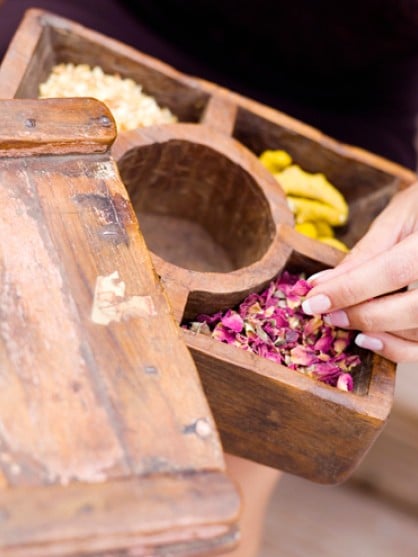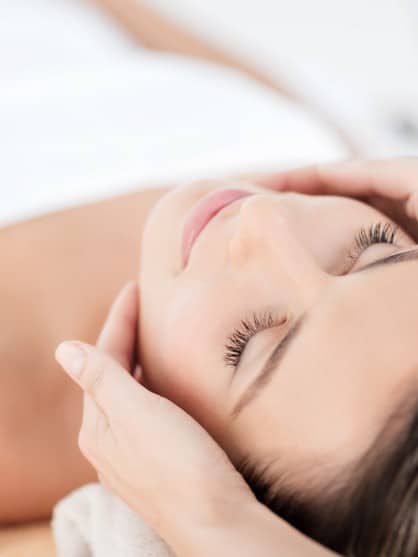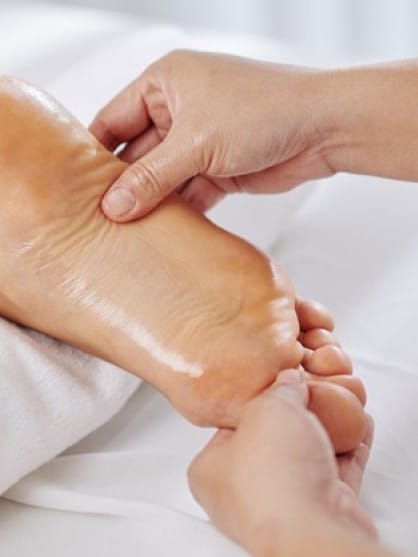Ayurvedic Massage
Ayurvedic massage is a special technique of deep tissue manipulation that aims to balance the physical and mental aspects of the body. The primary goal of this massage is to ensure the free flow of energy channels within the body, as Ayurvedic teachings suggest that all pathologies arise from the obstruction of these energy flows. At PIED-DE-POULE salons, well-trained professional massage therapists will introduce clients to the fascinating world of Eastern practices.

Indications and Contraindications for Ayurvedic Massage
Ayurvedic massage is known to address a range of issues, including:
- General fatigue, chronic tiredness, and apathy.
- Circulation problems.
- Lymphatic system congestion.
- Cholesterol buildup.
- Pain due to osteochondrosis.
- Insomnia.
- Stress, psychological and emotional tension.
- Unstable blood pressure.
- Headaches.
- Spinal and joint disorders, and more.
However, like any powerful intervention on the body, Ayurvedic massage has certain contraindications, such as:
- Individual intolerance and allergic reactions to herbs and oils used in the procedure.
- Colds, infections, or chronic diseases in an acute stage.
- Skin conditions, wounds, or abscesses.
- Gastrointestinal issues.
- Oncological diseases. Ayurvedic massage is also not recommended during pregnancy.
It's important not to disregard these contraindications. While specialists at PIED-DE-POULE salon will inquire about your medical history and current condition, it's crucial to be attentive to your own well-being.

Ayurvedic Massage Techniques
In the practice of therapeutic interventions using Ayurvedic techniques, several types of massages are distinguished. They all adhere to the main principle of creating a balance between energy and the physical body, but they differ in execution.
Abhyanga: This type of massage is considered a classic in Ayurveda. It involves an energetic four-handed massage using aromatic oils and incense. It provides an energy boost while inducing deep relaxation.
Marma: Marma involves the targeted application of pressure to energy zones. It activates the body's protective and restorative functions, helping individuals achieve physical and psychological well-being quickly.
Garshan: Garshan is a "dry" massage technique where the therapist wears silk gloves. The static electricity generated by friction enhances skin tone, refreshes the body, and reduces excess fluid retention.
These techniques represent just a small part of Eastern healing practices. The most suitable technique for you is determined through a personal consultation with a specialist, taking into account the duration of the course, its cyclicality, and the selection of oils and incense.

Unique Features of Ayurvedic Massage
Massages based on Ayurvedic principles are comprehensive. They combine the skills of massage therapists with the use of oils, incense, acupuncture, stretching, and more.
Most procedures involve a continuous application of oil, which can include:
- Sunflower oil.
- Castor oil.
- Olive oil.
- Mustard oil.
- Coconut oil, or specially prepared oils with therapeutic herbs.
These oils are heated to a comfortable temperature and often combined with medicinal herbs.
Specialists typically consider morning or evening as the most suitable times for Ayurvedic massages.
At PIED-DE-POULE salons, Ayurvedic massages are available throughout the day. Listen to your body and come to experience these new practices, as they might elevate the quality of your life.
Customer reviews
-
I adore PDP. I especially like hairdresser Yana who works in a salon located on Shota Rustaveli Street. After her great work my hair looks stunning and shiny. This is the best salon for me in all respects. There is always a cool atmosphere and friendly beauty experts.
-
I like styling and makeup in PDP. There is always a great atmosphere, I feel as at home. I also get a lot of compliments concerning my styling and makeup on different events. Of course, I always recommend PIED-DE-POULE beauty salon to all of my friends.
-
I have been regularly visiting PIED-DE-POULE for BRAE hair care for more than a year. Thanks to this procedure I grew health dreamed length of hair. I do styling more often than care. I like that different beauty experts work with me but I always get the same professional services.
-
I have been visiting this lovely beauty salon for a year already and I am extremely satisfied with service quality. These are the procedures I do on a regular basis! All the specialists always follow my requests! I especially adore a beauty expert whose name’s Maxim. He is just wonderful specialist! I am extremely thankful for the service quality.
-
I wish to express my gratitude to PIED-DE-POULE! The staff took into account all my wishes concerning the choice of hair color. The result was just wonderful! Also, I had a facial peeling and pedicure – all in all, I liked the service!
-
I have been a regular customer of the network of PIED-DE-POULE beauty salons for more than two years. I visit PDP on Shota Rustaveli most often as far as its location is convenient for me. Additionally, my favorite makeup artist, Ira, works there.
-
I visited PDP for the Balmain hair treatment (we tried to solve the problem of dry hair after lighting into blonde). Hairdresser’s name is Iia. She has told me about hair care and helped me to choose right products for my hair. I am really satisfied with her work. This “ritual” is my chance to grow length again after being blonde and having a bob).
-
PIED-DE-POULE beauty salon has been one of my favorite places in Kyiv for many years. I always choose and visit only this salon and I do not go to other places. There is always friendly atmosphere and professionalism of high-level. What is more, there is one significant point: if you come to PDP and you are hungry, the staff can offer you a menu with delicious and healthy food which can be delivered really fast!
-
I have been visiting PIED-DE-POULE for two years already and I am thrilled with the quality of the procedures, all the staff and communication. I like the possibility to always choose the most suitable time for me. Also, thanks to the salon, I never miss any new product of beauty industry and especially products for hair care as far as I enjoy them much!